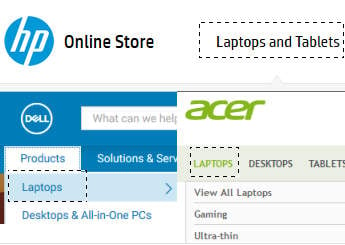Today technology allows devices to be slimmer, smaller and better for mobile computing by design. Options that once defined the difference between a laptop and notebook computer are separated by a small, almost invisible fine line today.
In this definition...
Is there really a difference between a laptop and notebook computer?
For most consumers shopping for a mobile (or portable) computer system the short answer is no. In fact, many consumers will look for a notebook but find almost everything is now called a laptop.
Technically and traditionally, the difference between the two is a matter of device size and weight, but advances in technology have resulted in much smaller and lighter components so this is much less of an issue. Today, the difference between a laptop and notebook is mainly what the manufacturer chooses to call its product.
What is a notebook computer?
(n.) A notebook is an extremely lightweight personal computer. Notebook computers typically weigh less than six pounds and are small enough to fit easily in a briefcase. Notebook computers use a variety of techniques, known as flat-panel technologies, to produce a lightweight and non-bulky display screen. In terms of computing power, modern notebook computers are nearly equivalent to personal computers. They have the same CPUs, memory capacity and disk drives. However, all this power in a small package is expensive.
Notebook computers come with battery packs that enable you to run them without plugging them in. However, the batteries need to be recharged every few hours.
What is a laptop computer?
(n.) A laptop is a small, portable computer — small enough that it can sit on your lap. Nowadays, laptop computers are more frequently called notebook computers, though technically laptops are somewhat larger in size than notebooks, in both thickness and weight.

What is the difference between a laptop and a notebook?
The laptop was originally designed to be similar to a desktop, but be small and light enough to be used sitting in your lap. For this reason, years ago, you would find that a laptop had more features than notebooks did, but the trade-off was being larger and heavier than a notebook. This is because the notebook style of portable computers was for mobility, not portability. To be a more mobile device, the notebook was a thinner design and it weighed less than the laptop, simply because it didn’t come packed with features and multiple devices and drives.
Years ago, notebook computers would have a smaller display than a laptop, fewer internal drives (hard drive or CD/DVD-ROM – depending on the year manufactured), and the sound, modem, and such would be integrated — not separate upgradable hardware devices. Laptops were considered to be desktop replacements; portable computers with features, functions, and options comparable to your desktop computer.
So while there technically is a difference between the two — and that is the size and weight of the device (which in turn impacts the system’s features) — today there is even less of a difference between the two since technology advancements means that most common computer devices and peripherals are much smaller now.
For example, When NEC released its UltraLite Notebook in 1989, a portable PC that many attribute to being the first notebook computer, it contained a CPU, RAM, ROM, 2MB solid state memory storage, a built-in modem and one RS-232C port. It weighed 5 pounds. The laptops from around this same time frame, such as the Compaq SLT/286, would typically have a CPU, memory, hard drive, floppy drive, VGA display and could weigh up to 12 or 14 pounds. The laptop was typically two to three times the thickness of the notebook.
Editor’s Recommendation: Need help understanding mobile computers? Our Webopedia technology term definitions will help you better understand the terminology: laptop computer, notebook computer, subnotebook computer, desktop computer, battery packs and portable.
Is the term “notebook phased out?
Today, technology allows devices to be slimmer, smaller and better for mobile computing by design, so the size of portable computers (both in thickness and weight) is decreasing. For this reason, options that once defined the difference between a laptop and notebook computer are separated by a small, almost invisible fine line today.
When we first compiled information for this article in 2008 there was still a difference between laptop and notebook computers. By 2012, however, we could see the term laptop used less frequently because a portable “comparable to desktop” system could easily lead to heat discomfort and possible injury if left in your lap for extended periods of time. By calling a laptop a notebook, it basically removes the association that device is well-suited to being used only on your lap.
At this time we could also see that mobile computing manufacturers would drop term laptop completely from their product lineup in favor of the term notebook. For example, HP offered a selection of “Performance Notebooks,” starting at 6.1 pounds with 15.4″ – 17″ displays and a line of “Balanced Mobility Notebooks” starting at 4.7 pounds with “14.1” – 17″ displays. Acer was selling its Aspire and TravelMate notebook series. Gateway, Sharp, Sony, NEC, IBM, Fujitsu, and others all used notebook to describe products, while Dell remained one of a few manufacturers who use the term laptop on its Web site to market their mobile computing systems.
Fast forward again to 2018 and we see that many manufacturers now list products as laptops to differentiate between portable computers and similar “book-like” devices including Chromebooks and tablets. Big names, including Dell, HP and Acer all offer lines of home, business and gaming laptops. Online vendors and ecommerce shops also tend to list categories of laptops and not notebooks.

Regardless of the terminology that manufacturers choose use, it is still acceptable for consumers to use the two phrases interchangeably.
Did you know…?
UPDATED: This article was updated on April 2, 2021 by Web Webster.


